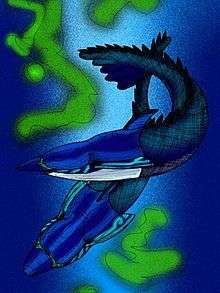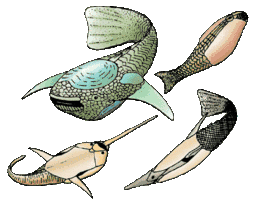Heterostraci
Heterostraci (Ancient Greek, ἕτερος+ὄστρακον "different scales") is an extinct subclass of pteraspidomorph jawless vertebrate that lived primarily in marine and estuary environments. The first identifiable heterostracans appear in the fossil record during the Early Silurian, and all, save for the Psammosteids, became extinct by the start of the late Devonian. This last group of heterostracans died out in the extinction event at the end of the Devonian.
| Heterostraci | |
|---|---|
 | |
| Panamintaspis | |
| Scientific classification | |
| Kingdom: | Animalia |
| Phylum: | Chordata |
| Superclass: | Agnatha |
| Class: | †Pteraspidomorphi |
| Subclass: | †Heterostraci Lankester 1868 |
| Orders | |
| |

Description and anatomy
The Heterostracans differed from other Paleozoic agnathan taxa both in the arrangement and histology of their scales.
Most heterostracans had two plates which form a large dorsal shield and a large ventral shield, and had series of scales arranged in various patterns on the sides of their bodies, the exact pattern differing from one group to another. In a few primitive forms, such as Lepidaspis, the dorsal and ventral shields are composed of a mosaic of tiny scales. In most other known forms, though, these tiny scales have fused together to form the shield-plates.
The scales of heterostracans are histologically distinct from other vertebrates, having three layers composed of dentine and aspidine, an acellular bony tissue unique to animals of this class and Thelodonti. The middle layer was honeycombed with tiny spaces called "cancella."
As with many agnathan groups, heterostracans had no fins besides the tail or caudal fin. In some pteraspids, especially in the psammosteids, the ends of the branchial plates (the plates that covered the gills) is drawn out to form wing-like extensions.
Taxonomy
Heterostraca is divided into several orders, including the two most diverse orders, Cyathaspidiformes ("Cup Shields"), and Pteraspidiformes ("Wing Shields"), as well as the Cardipeltida, Corvaspidida, Tolypelepidida, Tesseraspidida, and the Traquairaspidiformes. The predominantly Silurian Tolypelepidida (the best known member being Athenaegis), is regarded as being a sister group of the Cyathaspids and Pteraspidids, while the Early Devonian Lepidaspis is regarded as being incertae sedis, possibly close to the original basal forms.
Cyathaspidiformes
Cyathaspidiformes is divided into two main subgroups: the Amphiaspidida of Early Devonian Siberia (i.e., Amphiaspis, Gabreyaspis, and Edaphaspis, grouped together with their relative Ctenaspis of Canada), and the Cyathaspidida (i.e., Cyathaspis, Poraspis, and Anglaspis), grouped together with their relative Nahanbiaspis.
Pteraspidiformes
The Pteraspidiformes is divided up into five families, four of which, Anchipteraspididae, Gigantaspididae, Pteraspididae, and Protaspididae are monophyletic: Protopteraspididae has recently been determined to be paraphyletic within Pteraspidiformes, and thus, no longer valid, while Psammosteidae is now regarded as a separate subtaxon within Pteraspidiformes, "Psammosteida," as the sister taxon of the most basal family, Anchipteraspidae. Pteraspididae, Gigantaspididae and Protaspididae, in turn form the suborder Pteraspidoidei, with various genera of Protopteraspididae as sister taxa.[3]
References
- Sansom, Robert S.; Randle, Emma; Donoghue, Philip C. J. (February 7, 2015). "Discriminating signal from noise in the fossil record of early vertebrates reveals cryptic evolutionary history". Proceedings of the Royal Society B. 282 (1800): 20142245. doi:10.1098/rspb.2014.2245. PMC 4298210. PMID 25520359.
- Janvier, Philippe (1997) Heterostraci The Tree of Life Web Project.
- Pernegre, Vincent N., and David K. Elliott. "Phylogeny of the Pteraspidiformes (Heterostraci), Silurian–Devonian jawless vertebrates." Zoologica Scripta 37.4 (2008): 391-403.
- Haaramo, Mikko (2007). "†Pteraspidomorphi". Mikko's Phylogeny Archive. Retrieved 30 December 2016.